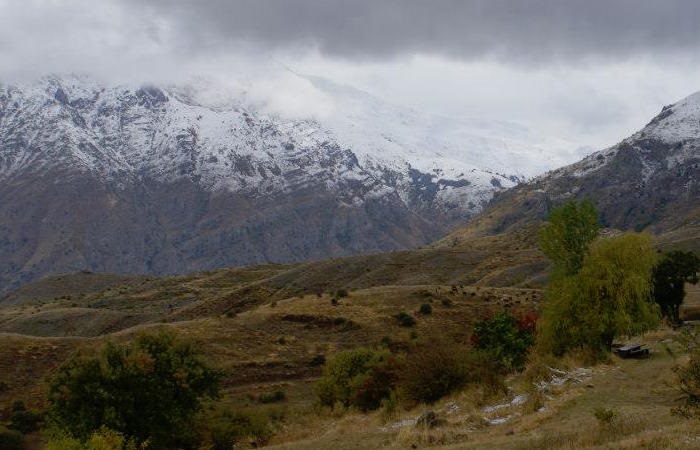Armenia is located in the Lesser Caucasus Mountains at the south-eastern limits of the Western Palaearctic. It is contiguous to Iran, Turkey, Georgia and Azerbaijan and situated at the junction of Europe, Asia and the Middle East. It is primarily a mountainous country with elevations above sea level ranging from 379m to 4,090m, and with the average elevation is about 1,800m above sea level. Various factors, such as the country’s geographical situation, climate and complex geomorphology lead to there being a variety of landscapes and habitats from rocky semi-deserts and mountain steppes to mixed, open juniper and deciduous forests and alpine meadows. The country is crossed by several mountain ranges (Pambak, Geghama, Vardenis, Zangezur etc.), separated with river valleys, the largest of which are Arax, Debed, Akhuryan, Arpa, and Voghji rivers.

Armenia also has numerous smaller rivers running down the mountain slopes, waterlogged meadows and marshes, and various artificial wetlands, such as irrigation canals, fish farming ponds and reservoirs. Natural lakes of variable size found throughout the country, mostly in highlands, the largest of them are Lakes Sevan and Arpilich. The landscape of southern Armenia is particularly rocky, and high cliffs and deep canyons are abundant here. In all regions from lowlands to mid elevations around human habitations are scattered cereal and vegetable fields, gardens and orchards.
These conditions result in unusually rich diversity of flora and fauna in a relatively small country’s territory. Up to the present at least 345 bird species have been reliably recorded in Armenia, of which over 240 species breed here. Many European bird species are represented in Armenia by regional forms, which are normally encountered during a birding trip to the country, while a spring-summer trip of 8-10 days one’s list typically reaches 200-220 species, stuffed with almost all of the Caucasian specialities.
Lakes Sevan and Arpilich hold the world’s largest breeding colonies of Armenian Gull, Citrine Wagtail [recently established as a breeder here], while the latter lake also supports a small breeding population of Dalmatian Pelican. Fish farms in the Ararat plane are home to Glossy Ibis, Pygmy Cormorant, Marbled, Ferruginous and White-headed Ducks. The reeds and scrub here host Ménétries’s, Moustached, Paddyfield and Savi’s Warblers; on the surrounding salt planes White-tailed Lapwing breed and banks of canals are inhabited with White-winged and Whiskered Terns and Blue-cheeked Bee-eater.
The deciduous mountain forests are full of a variety of birds, among which are Lesser-spotted Eagle, Black, Green and Middle-spotted Woodpeckers, samamisicus Redstart, Greenish Warbler, Mountain Chiffchaff, and Red-breasted & Semi-collared Flycatchers. The talus slopes that have scrub above the timberline are home to Caucasian Grouse, ‘magna’ Bluethroat and Radde’s Accentor, while in the alpine meadows with mountain springs Horned Lark, ‘Caucasian’ Twite and Red-fronted Serin are found. Crags and scree adjoining the alpine meadows are inhabited by Caspian Snowcock, Crimson-winged Finch and Wallcreeper.
Armenia holds an excellent selection of diurnal and nocturnal birds of prey, including the four European vultures, Short-toed Eagle, Levant Sparrowhawk, Lesser Kestrel, Lanner, Eagle Owl and an isolated relict population of ‘Caucasian’ Tengmalm’s Owl.
Arid hills with rock outcrops in the Arax valley host Black-bellied Sandgrouse, Finsch’s Wheatear, Pale Rockfinch, Trumpeter and Mongolian Finches and Grey-necked Bunting. The foothills of mountains are inhabited by Bimaculated Lark and armenicus Stonechat, in dry gorges with shrubs you can find Eastern Rock Nuthatch, White-throated Robin, Eastern Orphean and Upcher’s Warblers.
Visiting extreme south of the country near the border with Iran can produce observations of Black Francolin, recently discovered here See-see Partridge, chrysopygia Red-tailed Wheatear and Sombre Tit.
Situated on an important migration flyway Armenia offers superb opportunities to see, among many others, such passage migrants as Demoiselle Crane, Black-winged Pratincole, Broad-billed, Terek and Marsh Sandpipers, Pallas’s Gull, Calandra Lark and others. Raptor passage is spectacular and migrants include Eastern Imperial, Greater-spotted, Booted and Short-toed Eagles, Pallid and Montagu’s Harriers and Lesser Kestrel. More numerous are Lesser-spotted and Steppe Eagles, Black Kite, ‘Steppe’, Long-legged and Honey Buzzards.
May-June are the best months to visit in spring and summer and during the whole of September and October in autumn. The 8-12 days should be considered as the minimal period to get most of the country’s specialties. Road conditions have been significantly improved during the last few years, but long distance driving is nevertheless slow due to the snaking character of most highways and omnipresent mountain passes. Most of the off-road tracks in remote areas and those leading up to mountains require 4WD vehicles with an experienced driver. These could now be rented locally with or without an optional driver. Various hotels, B&Bs and house-stay-type accommodation are available in all regions of the country, while camping is also possible. Even during the hottest summers, when temperature in lowlands exceeds 30c-40c one should expect drastic weather changes high in the mountains, where sudden rain or hail storms are not unusual. Food in Armenia is cheap and diverse and traditional dishes are typically rich in herbs and vegetables, grown in the country.
The richness in birds and other wildlife in conjunction with the famous hospitality of the local people, delicious cuisine, numerous ancient historical and cultural monuments and some of the most impressive scenery in the Western Palaearctic, makes Armenia a worthwhile and rewarding destination for every keen birder. With the handful of resident observers and the lack of a local birdwatching club, large amounts of valuable bird observations from Armenia are still coming from visiting birders. And there are always chances for new discoveries here, as many parts of the country still remain under-watched.
Situated in the arid and salty semi-deserts of the Arax Valley, is one of the best known birding sites in the country. This is the largest fishery in the area with over 20 ponds where various Carp species are farmed. There is much marginal vegetation in places and reedbeds can be extensive providing excellent habitat for a range of waterbirds during the breeding season, passage periods and winter. With the loss and degradation of other wetlands in Armenia this site is becoming increasingly important and thoroughly deserves official protection. Breeding species include Pygmy Cormorant, Great Crested Grebe and ducks including Ruddy Shelduck, Red-crested Pochard, Ferruginous Duck and small numbers of Marbled Duck. Several pairs of White-headed Duck and Blue-cheeked Bee-eaters are found to be regular breeders here. Larger wading birds are common and include Glossy Ibis and White Stork as well as Little, Black-crowned Night, Squacco and Purple Herons and Little and Cattle Egrets. White-tailed Plover and Savi`s Warbler are recent colonists, Collared Pratincole, Kentish and Little Ringed Plovers also breed. A good range of wetland warblers is possible in the reedbeds here with Cetti`s, Sedge and Moustached, Paddyfield, Reed and Great Reed all present. Other passerines include Bearded Reedling, Lesser Short-toed Lark, ‘Black-headed’ Wagtail and a thick-billed race of Reed Bunting.
This mountain lies to the north-west of Armenia`s capital, Yerevan, and reaches 4090m. It is an excellent area for montane species Horned Lark, Alpine Accentor, Wallcreeper and Snow Finch occur in the more upland areas around Lake Kari along with high-altitude specialities of the area such as Water Pipit, ‘Caucasian’ Twite and Crimson-winged Finch. More widespread upland birds include both rock thrushes, Black Redstart, Northern Wheatear and Ring Ouzel. Western Rock Nuthatch, Ortolan Bunting and Red-billed Chough are common.
Raptors are impressive and include Short-toed, Booted and Lesser Spotted Eagles and Long-legged Buzzard in summer and Pallid Harrier and Steppe Eagle in autumn. The lower slopes and scrub hold more of the area`s specialities such as Radde`s Accentor, ‘Caucasian’ Bluethroat, White-throated Robin and the skulking and elusive Barred Warbler. Lesser Grey Shrike also occurs as well as Lesser Whitethroat Cetti`s Warbler and Black-headed Bunting. More wooded areas are home to Goshawk, Mountain Chiffchaff, Golden Oriole and Syrian Woodpecker. Arid foothills of Aragats host Finsch’s and Isabelline Wheatears, Bimaculated Lark and ‘Armenian’ Stonechat.
Major Source: Fatbirder
Photo Source:
Map Source: Wiki Commons
